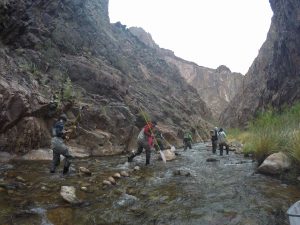By Katrina Rossos
Three University of Florida undergraduates and one recent alum volunteered for one week with Grand Canyon National Park Service. What was their main task? Electrofishing.
The students helped Grand Canyon park employees with the Brown Trout Removal Program, which is focused on eliminating invasive brown trout from Bright Angel Creek through backpack electrofishing. As an invasive species, the brown trout is eating some of the canyon’s native fish, including the humpback chub, which is listed as endangered.

Alan Ivory, a WEC alum who recently graduated in December 2019; two wildlife ecology and conservation seniors, Jamie Casteel and Yasmin Tavares; and Connor Morang, a junior studying environmental science, participated in the program in Grand Canyon National Park. Each student stayed one week in the Grand Canyon at various times in December and January. They resided with park employees in a bunkhouse at Phantom Ranch, a historic cabin nestled at bottom of the Grand Canyon – and the only lodging beneath the canyon’s rim.
“Our students worked cooperatively with NPS staff to complete the work,” Bill Pine, wildlife ecology and conservation professor, said. “This project has been ongoing for many years, so NPS has worked out the logistical and operational details, so it really is a perfect opportunity for students to move from excited and unskilled to excited and skilled in just a few days.”
Since 2003, Pine has worked with Grand Canyon National Park and other federal, state, and tribal resource management agencies in Grand Canyon as a volunteer, analyst, and project principal investigator. Now, he is back volunteering. Brian Healy, a long-time cooperator of the NPS, contacted Pine in the fall to find out if any UF students might want to volunteer for the Brown Trout Removal Program. Pine knew that interest would not be a problem.
Connecting the Students to the Experience
Pine advertised the opportunity and students submitted an application to participate. The partners at the NPS made the final selections for their teams based on student experience, interest in the program, and availability.

Wildlife Ecology and Conservation Department Chair Eric Hellgren was able to supply a $250 travel award for the WEC students in this program. Additionally, the College of Agriculture and Life Sciences Deans Office was able to support one student on this project as well, according to Pine.
“Initially, I was unable to go on the trip due to financial reasons, however, IFAS was able to provide me with travel support which made the trip possible,” Morang said.
“Holding the Lightning”
“I got to do a little bit of everything when I was there, I did a lot of netting and bucket carrying, I worked the backpack shocker, PIT-tagged a lot of suckers, recorded data, counted speckled dace, and measured and weighed the fish,” Casteel explained.
For backpack electrofishing, two people held the electrofishing poles and seven people stood behind them holding nets and buckets—one for native fish and one for trout. The students would walk upstream in approximately 150-meter transects, making three passes through each transect. After each pass through the transect, the team would process the fish.
The teams measured, weighed, sexed, and checked for color and ripeness of the native fish and the trout that were caught. If the native fish were big enough, they were tagged with electronic passive integrated transponders (PIT) for monitoring purposes and released above the shocking area, so they would not get shocked twice. The team euthanized the invasive brown trout that were caught and cleaned them on site.

The invasive brown trout were not wasted, however. They were eaten. While the project team ate some of the fish, the rest of the trout was helicoptered out for consumption elsewhere. The fish that were too small to eat were sent to eagle aviaries.
While there are still a lot of brown trout in the main river, the trout removal project has been very successful in Bright Angel Creek. The NPS caught thousands of brown trout in the creek within three months when the project first began. Now, the team is catching hundreds of native fish, like speckled dace, every day, and only catching several invasive trout.
“The most memorable part of the trip was catching a native humpback chub on Christmas day, their population had previously been decimated and now, thanks to conservation work with the NPS, they are recovering,” Morang said.
Remarkable Experiences
“[This experience] was a good way to prove to myself that I can accomplish anything I want in life. I started the trip with a positive attitude and desire to experience something new and special,” Tavares said. “I can’t say the hiking wasn’t challenging enough or working at the Bright Angel Creek wasn’t intense. However, my love for nature and determination with this project helped me to overcome these arduous situations and truly enjoy every single step I took along this trip.”
Beyond the amazing experience of living and working in the Grand Canyon, this opportunity was an excellent way for the students to collaborate with the wildlife ecology and conservation department’s NPS partners on an applied research project, Pine said. Not only did the students learn the research aspect of the project, but they also gained a better understanding of the many duties of the NPS employees, including management and visitor interactions.
“I am extremely grateful for the ability to learn the management aspect of a field site in a national park,” Ivory said. “Because I was a part of the last trip of the field season, we had to organize, inventory, and fly out all of the gear with a helicopter, which was an amazing experience.”
 0
0
